The Premier League is back after the international break. After two weeks of training, Antonio Conte’s Tottenham gave a mixed performance in their first win under the new head coach. Despite a disappointing first half, the Lilywhites were able to come back from behind. Intriguingly, their opponents, Leeds United, also put in a strong display to make Tottenham suffered, but the result let Marcelo Bielsa down.
This tactical analysis will give a detailed analysis of both managers’ tactics, with specific focuses on how Conte modified his side during the halftime break.
Lineups
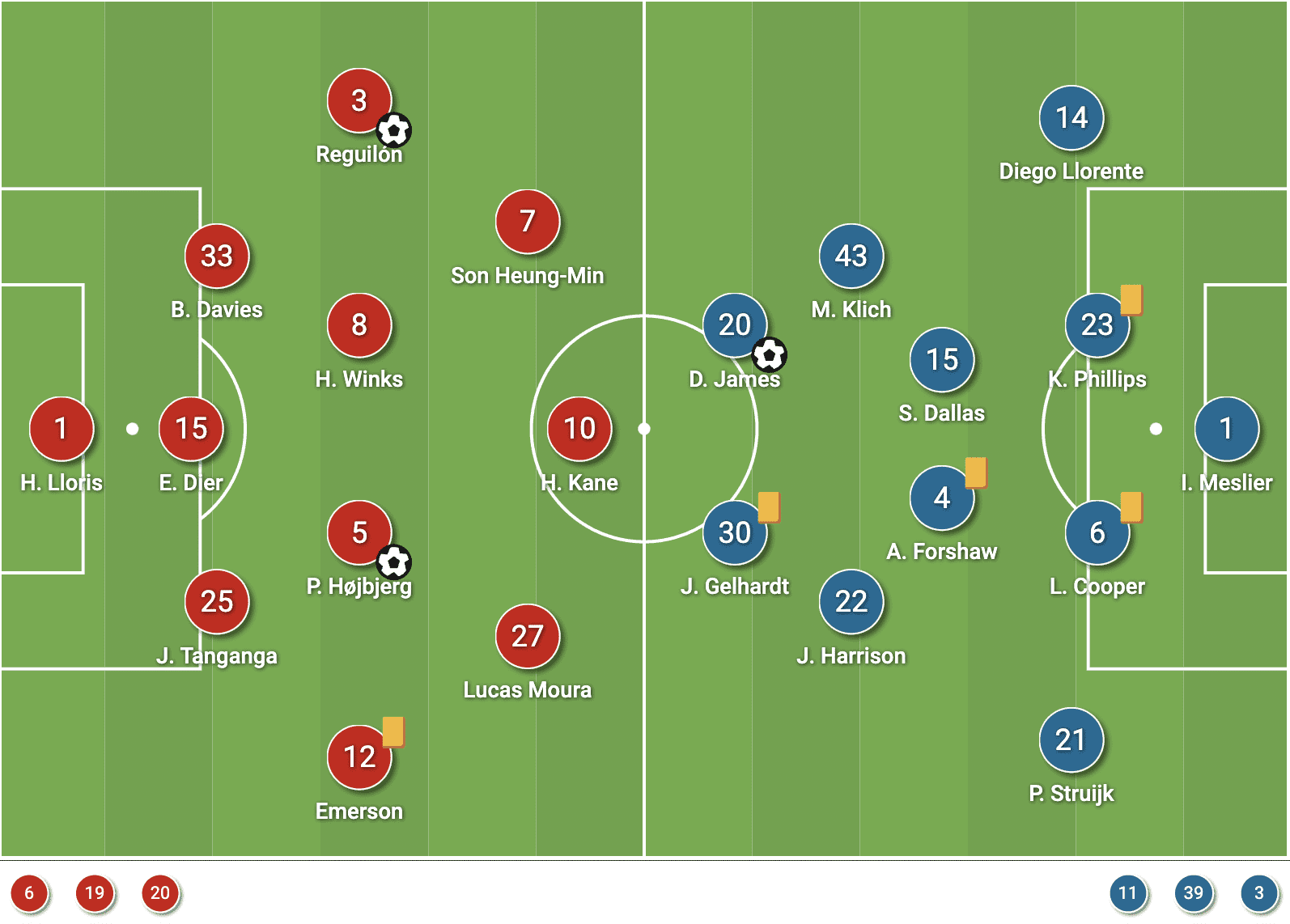
Tottenham continued to play with the trademark back three of Conte, it was a 3-4-3 on paper and very similar the last game. Only a few changes were made, including Japhet Tanganga to replace the injured Cristian Romero, and Harry Winks became the partner of Pierre-Emile Højbjerg instead of Oliver Skipp.
Bielsa might have had a headache when choosing his eleven, too many players were missing such as Raphinha, the Brazilian international. It was a 4-2-2-2 on paper with Daniel James and Joe Gelhardt as the strikers. It was also great to see Adam Forshaw start another game after the hip injury he has been struggling with. With Forshaw and Stuart Dallas in the midfield, Kalvin Phillips was moved to the backline to play as a central defender.
Leeds’ dynamic attacks
Although Leeds had a formation on paper, it was mostly a reference of how they wanted to man-mark the oppositions defensively, which we would explain more in the next section. Offensively, the structure and movements of Bielsa’s troops should not be limited by the formations, as they had very clear strategies on how they wanted to attack.
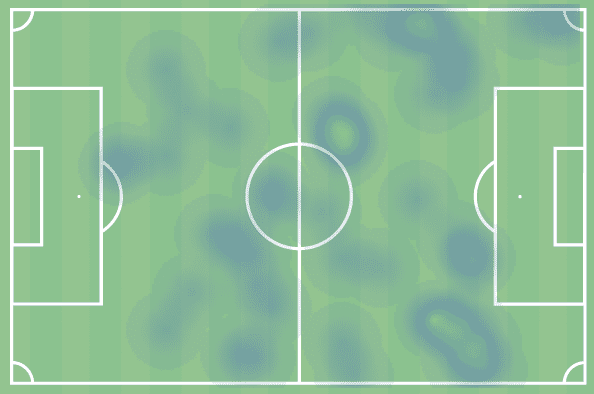
For example, you could see Mateusz Klich’s heat map above (Cr. Wyscout). He was a right-winger/right midfielder according to the information on the team sheet, but instead he was everywhere on the pitch. Apart from the right side, he also touched the ball quite often in the left half-space, as well as the touchline on that flank. It shows the players were grasping the principles of plays instead of being rigidly positioning themselves based on their positions.
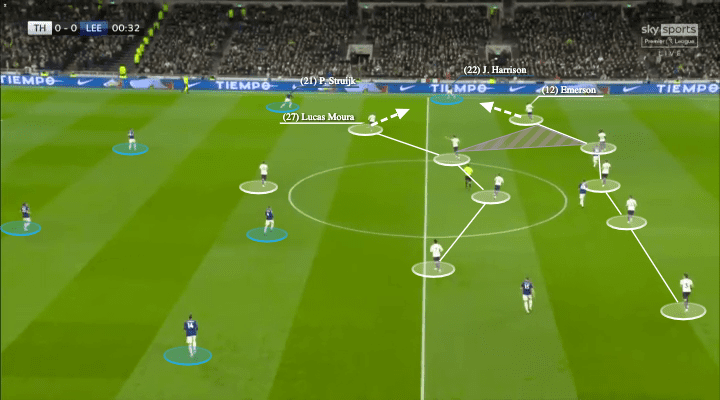
Leeds setup in a 4-1 shape in the construction phases of the attack, Forshaw is the holding midfielder to operate behind the first line. Then, they have high and wide wingers (Jack Harrison & James) to provide the widths and the offensive height, while they also need Dallas and Klich’s off-ball runs to support or freeing up spaces during the attack.
However, Leeds had a small issue regarding the half-space occupation. Particularly, as Harrison was wide and Forshaw was deep, they were missing the constant occupation of the purple area as indicated above. Although Gelhardt on occasions appeared in that zone, his technique was not good enough to retain the ball. Without a central and short passing option there, the question of Leeds was how to get out from the flank, apart from drifting towards the byline and cross.
Conte’s side were a bit conservative in the first half with a 5-4-1 midblock for most of the time. They let the opposition dictate possession and played easily into their own half. With a back five, the defenders had more courage to press earlier in the wide spaces, especially for the wing-backs, who should close these spaces. This allowed Tottenham to set pressing traps on the flanks. For example, when Pascal Struijk found Harrison up there, you could see Lucas Moura and Emerson Royal were going for the receiver.
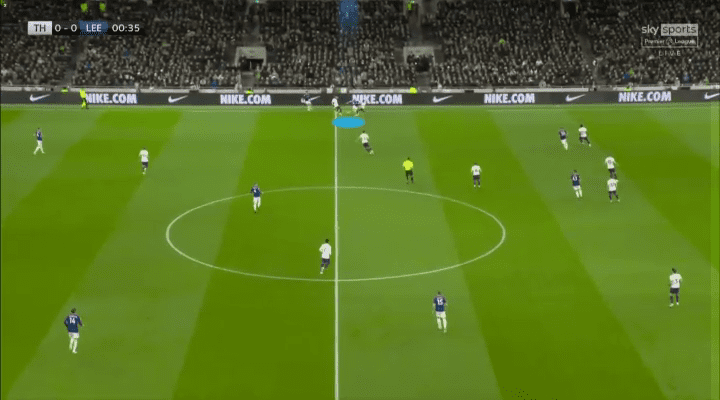
Hence, this allowed the duo to carry out a double-press on Harrison in the above image. With two angles of press, Tottenham had a slight advantage when the Leeds winger dropped to receive, given that movement always invited the wing-back to come up.
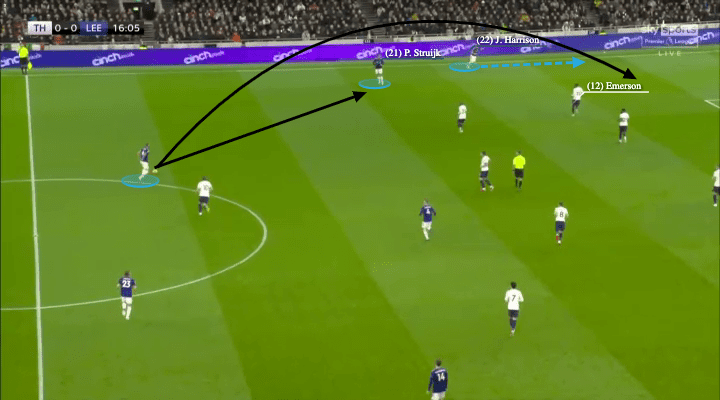
Therefore, the job of Leeds’ wingers should not be dropping in to receive on feet as that action would only kill spaces of the full-backs. In the above image, Harrison adapted to the game and used an alternative movement to pose questions on the Tottenham defence. It was very important as Bielsa’s side went out on the flanks in this game, and specifically, they targeted Royal’s side to attack and bagged a goal from the 1v1 there.
When the centre-back tried to play a progressive pass, he should be given two options on the same flank, one short and one was the longer option. Here, Harrison made an early movement to attack spaces behind the right wing-back, he forced Royal to drop back and brought him away from the left-back. The run itself also presented a long solution for Liam Cooper.
Meanwhile, as Harrison generated more spaces for Struijk, the left-back became a short passing option for Cooper. Given Moura was defending the half-space initially, Struijk would have spaces to play if he received.
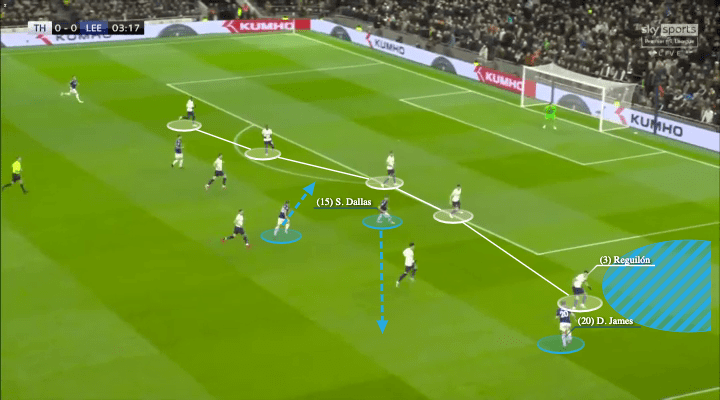
On the right side, Leeds wanted to use the speed, 1v1, and energy of James, who would come out from the striker position to play in the wide spaces. However, even James’ wide positioning pulled the defender out, the players were instructed to not make runs into zone 18 (or blue zone). This was because the former Manchester United man was a player who needed spaces to dribble and take on the opposition 1v1, and he liked to drive towards the byline.
If they wanted to support James, they should drop back a bit to offer a backward passing option as Dallas did above. Never killing those blue spaces was the most important.
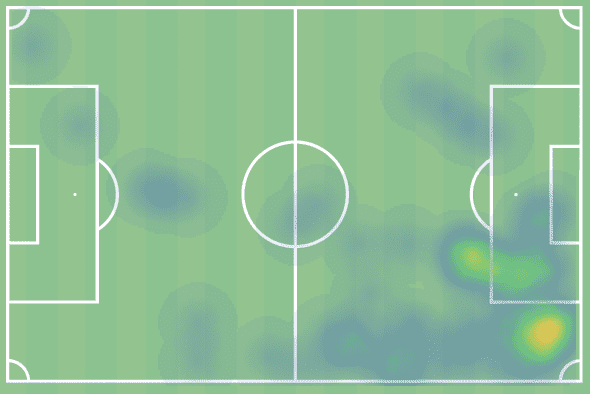
James’ heat map above matched our descriptions (Cr. Wyscout). He did operate in the centre, such as being a striker to finish the cross when the attack was from the other side. However, he also made great impacts in zone 18, just like a right-winger.
Offensive struggles of Tottenham
Tottenham used a similar approach to play out from the back as they did against Everton, but proved to be unsuccessful as the pressing of Leeds were spot on and intense.
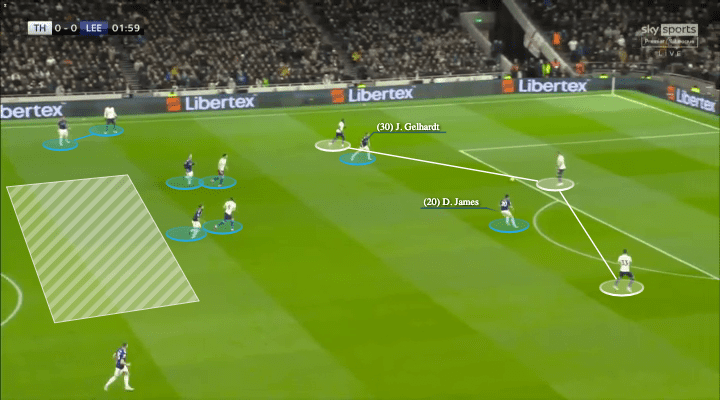
In the build-up, Tottenham used a 3-2 build-up shape with lower wing-backs to support on the flanks in the first half. This was a tactic against the man-oriented system of Leeds as they could use the deep midfielders to drag the opposition midfield up, and vacate spaces behind for the front three to receive (white zone).
As suggested above, we could use the 4-2-2-2 formation as a reference to interpret the defensive plan of Leeds. In the last line, against the front three, they would like to have a 4v3 advantage. Then, two midfielders could man-mark the two of Tottenham (Højbjerg & Winks), both wingers (Dallas & Harrison) were marking the wing-backs. In the first line, it was expected to concede a man, both strikers (James & Gelhardt) are required to make clever runs to shadow one centre-back while pressing the other centre-back.
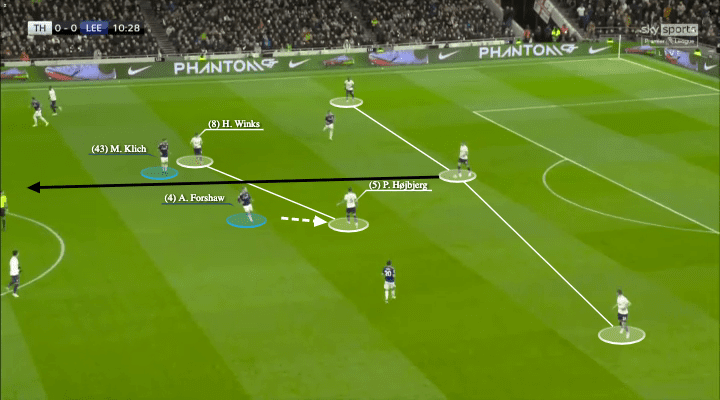
In the first half, Tottenham were trying to use those white spaces with vertical and longer passes to break lines. As mentioned, usually the wide centre-backs were controlled by the strikers, Eric Dier had more chances to play the forward passes than the others. From there, it was simple, with the movements of Højbjerg to open a wider passing lane, the Lilywhites progressed from there.
For example, Højbjerg dropped a bit towards Dier diagonally above, which pulled Forshaw away from the centre a bit. While Winks was static to fix Klich’s position, Dier could send a vertical ball through that channel.
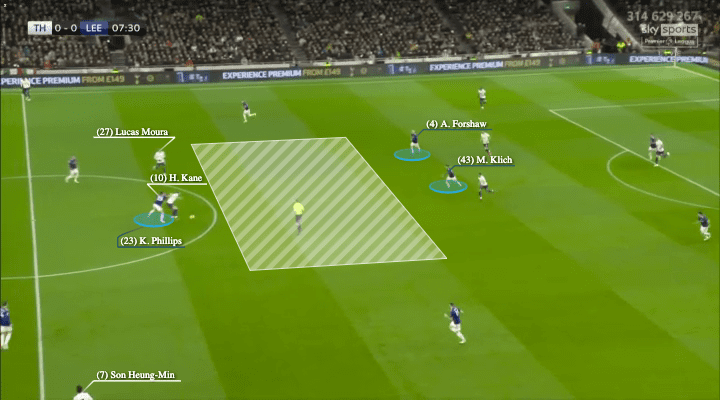
And this was how the Tottenham front three operated. It was a 3-4-3 on paper but in fact a 3-4-2-1 on the pitch, as Heung-Min Son and Moura were staying narrowly in the half-spaces and closer to Kane. The above image shows the way Conte’s men were able to pull the opposition out and vacate spaces in midfield. As Forshaw and Klich were high to man-mark Højbjerg and Winks, there were huge spaces (zone white) behind for Kane to take the touches.
Nevertheless, the receivers always faced difficulty, their markers were too close and prohibited their spaces to turn. For example, Phillips was tightly marking Kane so his English fellow could not face the goal, and if the Tottenham striker took more touches to adjust his angles, contacts must be made and Leeds were confident to win the ball back in those situations.
Probably Conte also perceived this as room for improvement as Kane was a bit different from Romelu Lukaku. In the second half, Moura was instructed to play in the midfield more to receive those passes, as the Brazilian player was more mobile and agile turn and go himself.
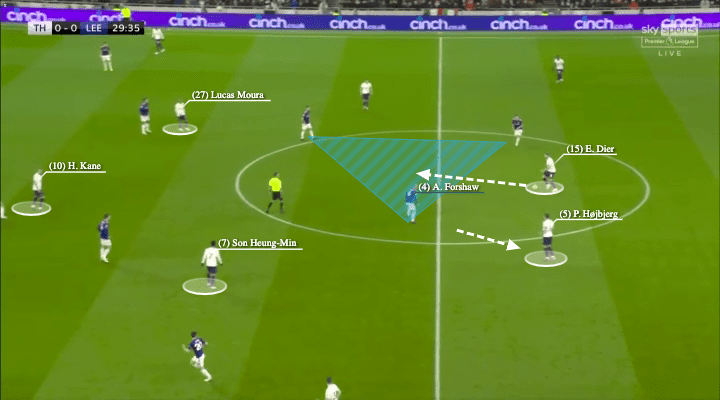
Apart from using the passes to exploit those spaces, Tottenham also tried to release their free player (Dier) to initiate an attack. The 27-year-old centre-back was brave to carry the ball forward, enjoying spaces created by teammates through the manipulation of man-marker.
We have an example through the above scenario. Højbjerg dropped diagonally to the last line, which pulled his marker (Forshaw) away from the centre a bit. The blue spaces were enlarged and given Tanganga and Ben Davies’ wide positionings to stretch the strikers, Dier could carry the ball forward in that space. But Forshaw was not stupid, he knew to what extent should he follow his target, and in this case, he eventually abandoned Højbjerg to close Dier.
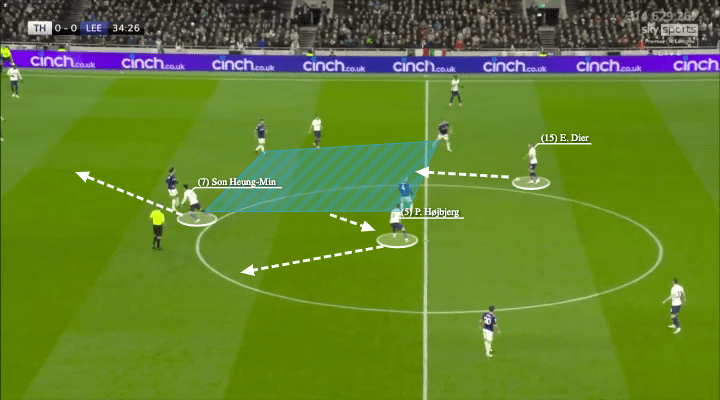
Dropping from the midfield was not Højbjerg’s only way to create spaces for his centre-backs. Apart from that, the Danish midfielder also had other movements to bring away his man-marker, the above image gives an alternative case.
This time, it was the forward movement to open spaces in the centre. Højbjerg initially dropped diagonally from the inside, which of course pulled Forshaw away. But then he did not stay, instead, he moved forward into spaces behind the midfield to force his marker to follow. With Son doing the same penetration run, their markers were pushed deeper so Dier received lighter pressure laterally.
However, despite all the strategies above, Tottenham failed to create opportunities in the first 45 as their final passes were missing. Also, when they attacked from the flanks, the number in the box was lacking, so they did not generate a goal threat in the penalty box either.
Conte’s side woke up in the second half
Even Conte himself admitted the performance in the first half was beyond satisfaction. During the break, he made significant changes in tactics to tweak the team’s playing style, injected more intensity into their game. This was reflected on the pitch as the Lilywhites were fresher and sharper when they came back. This section will break down the changes made by Conte in their defensive phase, offensive organization, and the offensive transitions.
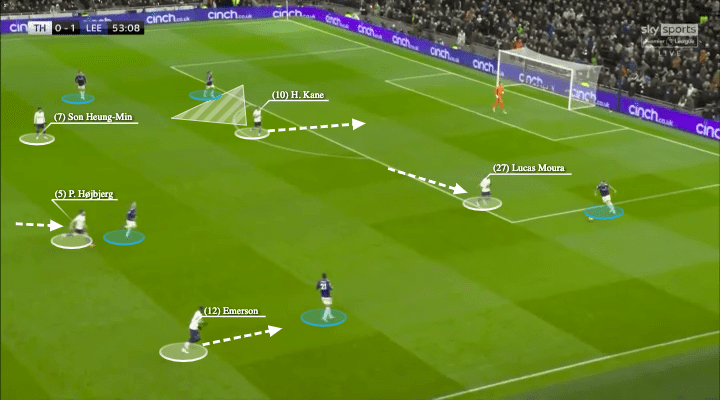
Firstly, from the defensive point of view, Tottenham were more aggressive without the ball. They did not sit in a midblock anymore, pushing the lines higher to press the opposition. Leeds could not move the ball easily as they did in the first half, resulting in higher and more frequent transitions.
Here, you could see Tottenham using the front three to press asymmetrically. With Kane in the centre to block the switch or cover the holding midfielder, Moura often came out to press Cooper. Then, Tottenham wing-back (Royal) went high to close the left-back, while Højbjerg also closed the holding midfielder as Kane was out. On the far side, Son had a good positional discipline to maintain compactness. This cut all short options for Leeds and their opponents went for long more often, where three Tottenham centre-backs were waiting for the duels and recover possession.
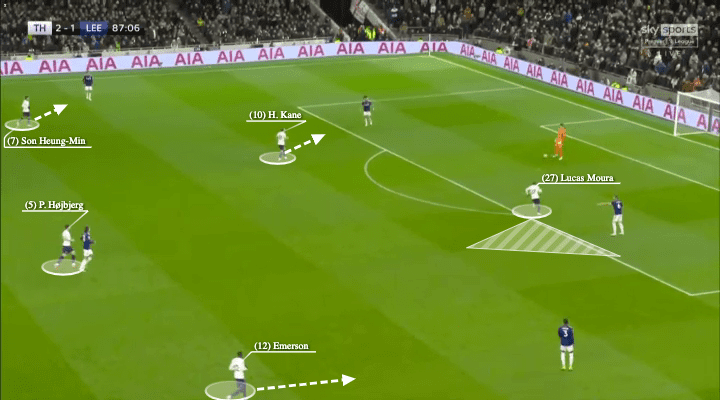
Conte’s troops should be praised for not sitting deep after Sergio Reguilón’s goal. They kept pressing the oppositions until the last kick of the game, which was impressive. The above screenshot shows their pressing in the 87th minute. Moura still put the pressure on Illan Meslier while covering the outside. Kane was on the other centre-back; Son was ready to press the right-back; Royal was high to press the left-back if Meslier lofted the ball to Junior Firpo. Do not forget Højbjerg also came out to support the press too.
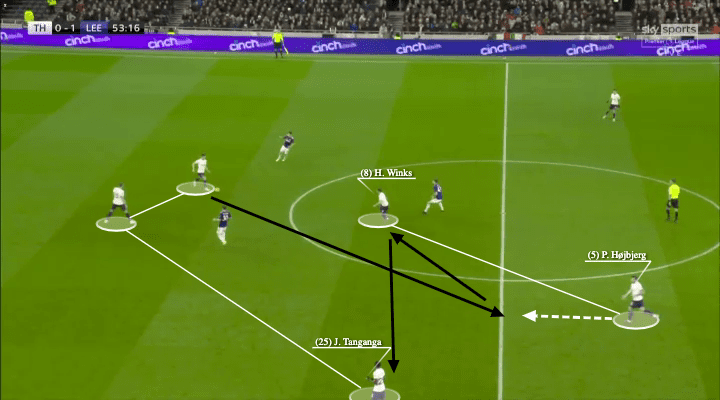
Meanwhile, in the construction of the attack, Tanganga was much better to get himself involved in the game. Compared to the relatively static positions in the first half, the young centre-back now operated as a hybrid player as he moved to higher spaces on the flank, you could interpret his role as a right-back.
The Tottenham midfielders also improved, especially Winks. Their positions were more flexible as Conte abandoned the use of two parallel deep midfielders. Instead, the duo was occupying alternative horizontal zones now to create a more staggered shape. The above image included all the features. Højbjerg dropped from a higher area to offer a good passing angle for Davies, while Winks served as the third man to release Tanganga, now the Lilywhites broke the first line successfully.
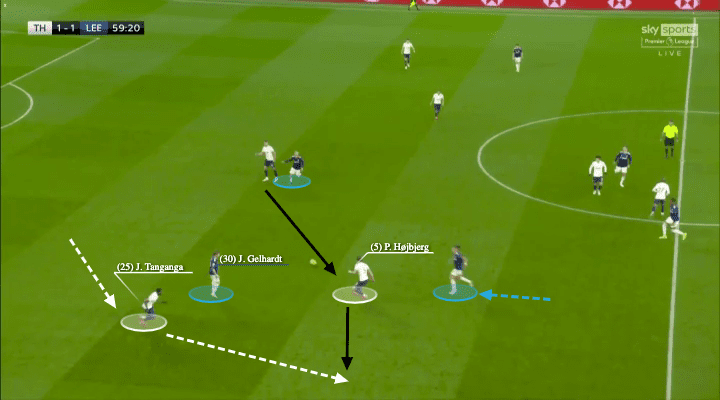
You could see more involvement of Tanganga through this image, the movement he made in the first phase was crucial to break the press. Here, Højbjerg dropped and pulled the marker out, offering a diagonal passing lane for Dier. But the former Southampton midfielder was not Tanguy Ndombélé, he could not take on the opposition and carry the ball forward. Hence, to further advance the attack, he needed a passing option. The move of Tanganga resulted in an outlet for Højbjerg, which was on Gelhardt’s blindside. The timing of the move was great as well as the 22-year-old player began his run before Højbjerg received, so he arrived at the space when the pass was made. With Royal pinning the full-back, Tottenham could go all the way.
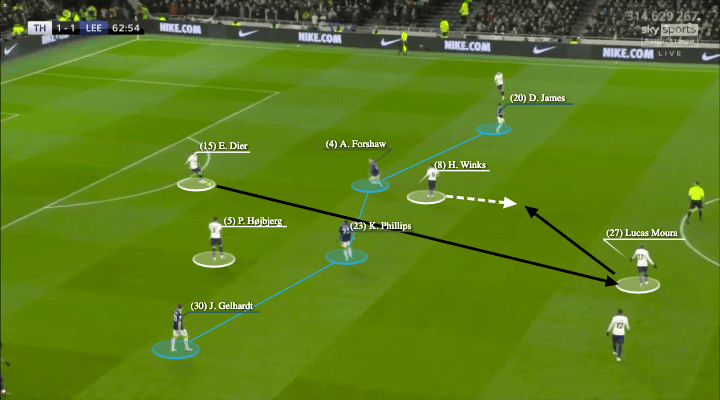
This example shows the changes in Conte’s approach. As we’ve said, Kane was not good at turning or escaping from the marker in spaces behind the midfield, they needed another man to link. Moura served this role very well in the second half. Firstly, Winks and Højbjerg stayed in alternative horizontal zones, which was an effort to offer a passing option behind the first line. Because of the same reason (Leeds strikers orienting themselves towards wide centre-backs), Dier could break the lines through the midfielders and connect Moura.
Particularly, Tottenham found it easier to break the press by escaping from Forshaw. The former Boro player had great passion for the game but sometimes he made reckless decisions to step up. When he abandoned the initial target, the opposition moved on his blindside to become the free player, such as Winks’ turn to receive Moura’s lay-off here.
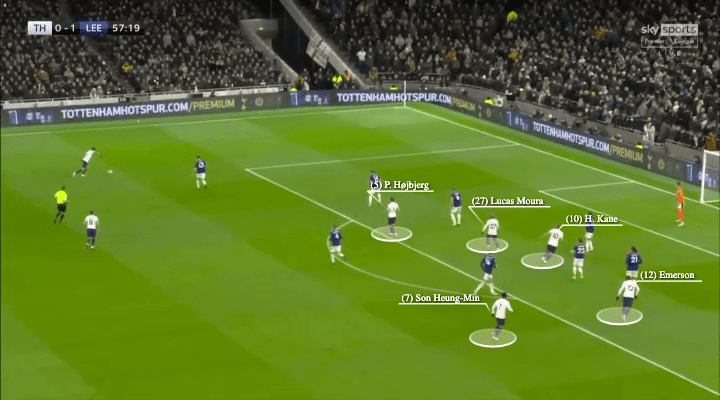
In the final third, Tottenham were more aggressive to attack the penalty box, and this indirectly resulted in the equalizer. Before Højbjerg put the ball past Meslier, the Lilywhites had the other four of the front five to attack the cross from Reguilón, including Royal going into the centre. Behind the first group of attackers, Son and Højbjerg was also lurking to catch the rebound and they scored from there.
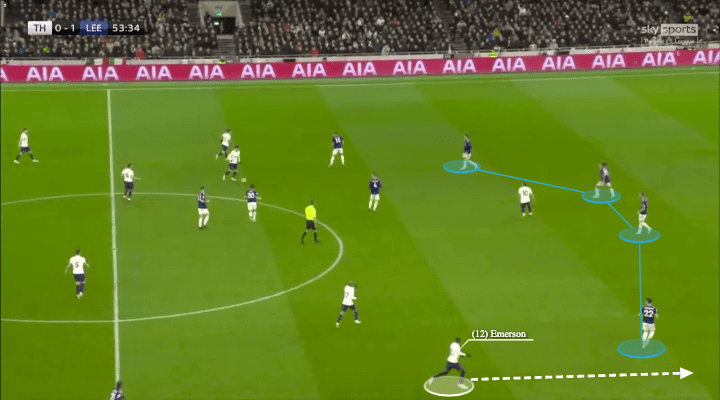
Another big change was the offensive transition, particularly, Royal was more proactive to join the attack early. Whenever he saw the team recover possession, the former Real Betis player would dash forward on the far right and run past the defence, which aimed to provide the width, stretch the channels, and push the last line deeper. Then, Tottenham could play through the gaps of the defence and exploit them by runners, such as the Kane chance that hit the post.
Conclusion
As our analysis has concluded, it was a really great second-half performance from Tottenham, they played like a completely different side and deserved to win the game. The intensity they injected after the break would be a good direction for the players, as they must have that to keep a place in Conte’s team. Hopefully, the likes of Kane and Son could be fitter soon to give the team more goals.
From Leeds’ perspective, it was disappointing to lose all three points away from home, especially given their strong performance during the first half, they could have achieved more if they grabbed more chances. The selection problems due to injury continued to be an issue of Bielsa, and if he had the likes of Patrick Bamford and Rodrigo Moreno, their attack would be even better.





Comments